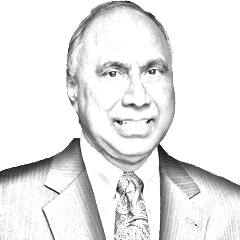Pakistan’s annual smog crisis, a recurring phenomenon, has reached alarming proportions, casting a dark shadow over the country’s urban centres. The dense fog of pollution, visible even from space, could have serious ramifications for the future of the nation.
I say this as someone who has been writing about environmental issues and climate change within Pakistan for several years. Based on my observations and analysis, it is evident that the current smog crisis is not an overnight phenomenon but rather the culmination of long-standing environmental challenges. Addressing these challenges correctly will require a collaborative approach. The causes of Pakistan’s smog crisis are multifaceted including a combination of natural and anthropogenic factors. Some of the primary contributors include:
Industrial Pollution: The industrial sector, particularly brick kilns and power plant, releases significant amounts of pollutants into the atmosphere.
The current smog crisis is not an overnight phenomenon but rather the culmination of long-standing environmental challenges.
Vehicle Emissions: The significant increase in the number of vehicles on the road, coupled with poor fuel quality and outdated emission standards, adds to air pollution. Most of the cars, buses and transportation vehicles use fossil fuels.
Agricultural Burning: Every year the practice of burning agricultural waste, particularly crop residue, releases harmful pollutants into the air. This practice prevalent in rural areas in Punjab province and in the neighbouring state of Indian Punjab contributes substantially to air pollution.
Meteorological Conditions: Thermal inversions, also known as inverted temperature conditions, hinder the vertical dispersion of air by trapping pollutants near the surface, resulting in the accumulation and persistence of smog in the lower atmosphere. The consequences of smog are far-reaching and severe ranging from health to the economy and from social to educational spheres.
Health authorities state that around 2 million people, kids and adults, have sought medical assistance related to polluted air over the past few weeks. Consistent and long-term exposure to smog can lead to a range of respiratory and cardiovascular problems, including asthma, bronchitis, lung cancer, and heart disease. Children, the elderly, and individuals with pre-existing health conditions are particularly vulnerable to the adverse effects of smog. To combat the health crisis, the Punjab government has already declared a health emergency in the province.
The smog has disrupted daily life. There have been school closures and education are suspended until further notice. Restaurants are mandated to close at 4 pm, with takeout services permitted until 8 pm. Authorities have implemented lockdown measures in the cities of Multan and Lahore, including the suspension of all construction activities in those areas. The economic impact of smog is affecting industries, tourism, and productivity. The crisis has forced many people to migrate to cleaner cities or countries, leading to significant social and economic consequences.
The Pakistani government has implemented various measures to address the smog crisis, including the introduction of cleaner fuels, the promotion of public transportation, and stricter regulations on industrial emissions. However, to date, these efforts have been insufficient to curb the problem. Collaboration and cooperation are essential in order to tackle this complex issue effectively. Sharing knowledge and technology, as well as implementing joint initiatives, can help mitigate the effects of smog.
Regional collaboration would be a big step forward toward curbing crop residue burning, which contributes significantly to smog across borders. Estimates suggest that its impact on air quality ranges from 9 percent annually across the subcontinent to as high as 40-60 percent during winter harvest months in northern India, when pollution levels peak. The Chief minister of Pakistani Punjab Maryam Nawaz earlier urged ‘climate diplomacy’ with India to combat smog. At the Pakistan Pavilion during the United Nations Climate Change Conference, known as COP 29, held in Baku, Azerbaijan from November 11-22, Pakistan representatives called for collaboration with India and across the South Asia region to confront its smog crisis.
In her remarks at COP 29, Sherry Rehman, Pakistan’s former climate change manager, took the need for collaboration beyond the region. After describing Pakistan’s dire climate change issues, she called for international assistance to help Pakistan and other developing and worst affected countries redress their problems. Specifically, she recommended “internationally determined contributions” from wealthy nations to align with the climate improvement plans of the worst affected countries.
The plan for addressing Pakistan’s smog crisis must set out a comprehensive and sustainable approach balancing environmental, economic, and social considerations. Strengthening environmental regulations will be crucial in order to limit emissions from industries and vehicles, supported by robust enforcement mechanisms. Transitioning to renewable energy sources, such as solar and wind power, will reduce dependency on fossil fuels and improve air quality.
Similarly, sustainable agricultural practices, including crop rotation and residue-free farming, must be promoted to mitigate pollution from crop burning. Public awareness campaigns will be essential to educate citizens about the health risks associated with smog and encourage environmentally responsible behaviour. Additionally, international cooperation, particularly with neighbouring countries, will be required in order to facilitate knowledge-sharing, technological advancements, and coordinated efforts to address transboundary pollution challenges.
By developing and implementing an integrated plan and policy framework with local, regional and global collaboration, Pakistan can tackle its smog crisis effectively. This will ensure a sustainable smog-free and positive future for the nation and its people.
The writer is an Entrepreneur, Civic leader, and Thought Leader based in Washington DC.
